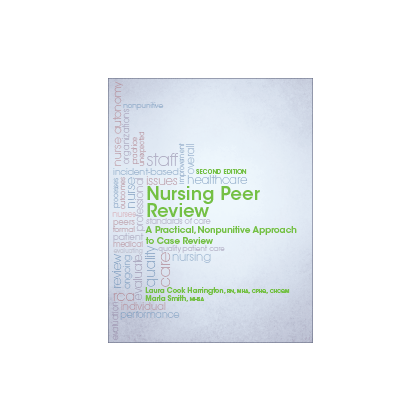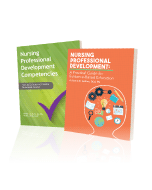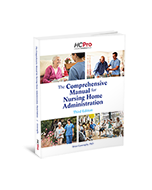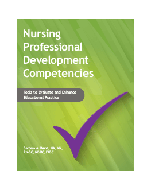Nursing Peer Review, Second Edition: A Practical, Nonpunitive Approach to Case Review
*Digital product and event terms may vary.
Nursing Peer Review, Second Edition: A Practical, Nonpunitive Approach to Case Review
Laura Harrington, RN, BSN, MHA, CPHQ, CPCQM
Marla Smith, MHSA
Nursing Peer Review, Second Edition, is a comprehensive guide for establishing a formal case-based nursing peer review program, including all the tools and procedures organizations need to build and manage a structure to conduct systematic evaluation of clinical care. The book takes nurse managers through every step of the process: explaining nonpunitive nursing peer review, creating a system, identifying cases, conducting reviews, and taking appropriate action based on the outcomes of the reviews.
Nurse leaders are responsible for upholding the ANA Code of Ethics, which concerns issues of accountability for the professional nurse and includes requirements for peer review to ensure high-quality patient care. This book offers them the processes to help do this. It provides a framework for nurses to hold them accountable for their practice, reveal educational gaps, help identify system and process errors, and indicate whether changes in practice are necessary to improve patient outcomes.
Inside this book, you will find all the resources you need to get your nursing case-based peer review program up and running, including:
- Details of the benefits and rationale of case-based nursing peer review
- Easy-to-follow, multi-step system for implementing a case-based peer review program
- In-depth content on how to conduct chart reviews
- Sample case studies to illustrate the case-based peer review process
- Tips on using case-based peer review data to benchmark performance and track and trend peer review results
- A comprehensive set of downloadable, customizable tools to create a structured, evidence-based, case-based peer review process
- The formal structure to conduct a systematic evaluation of clinical care
Meet the Authors:
Laura Harrington, RN, BSN, MHA, CPHQ, CPCQM, is executive director of quality and patient safety at Boston Medical Center. She formerly served as a senior consultant at The Greeley Company, where she specialized in quality and patient safety, external peer review, and risk management.
Marla Smith, MHSA, is a consultant for HCPro who focuses on quality and peer review solutions. She formerly served as an associate consultant for The Greeley Company in the quality and patient safety practice. Her areas of expertise are in medical staff and nursing peer review, medical and hospital quality performance improvement, and physician- and hospital-based data analysis.
Published: December 2014
Table of Contents:
Introduction
Chapter 1: Defining Incident-Based Peer Review
The Rise of Peer Review
How Facilities Use Peer Review
Chapter 2: Benefits, Rationale, and Setting Clear Expectations
The Roots of Peer Review
The Nursing Performance Pyramid
Applying the Pyramid to Nursing Culture
Chapter 3: Immunity, Confidentiality, and Protecting Information From Discovery
Peer Review Protection Laws
Immunity
Privilege: Protection From Discovery
Confidentiality: Security of Information
Chapter 4: Step 1: Design a Formal Committee to Support the Peer Review Process
Functions of Peer Review
Identify a Formal Structure That Works for You
Define Committee Roles and Responsibilities
Set and Communicate Nursing Expectations
Protect Confidential Information
Chapter 5: Step 2: Establish the Nursing Peer Review Process
Drafting a Peer Review Policy
Peer Review Process and Timelines
Case Identification, Screening, and Assignment of Nurse Reviewer
Review Ratings
Communicating Findings
Tracking Findings
Chapter 6: Step 3: Educate Nurse and Non-Nurse Stakeholders
Communicating the Mission
Involving Non-Nurse Stakeholders
Obtaining Buy-In
Conducting a Formal Presentation
Chapter 7: Step 4: Implement the Nursing Peer Review Process
Choose an Implementation Date
Conducting Chart Review
Scoring the First Case
Drafting the First Agenda
Holding the First Meeting
Final Determinations
Chapter 8: Step 5: Track and Trend Your Data
Peer Review as a Performance Improvement Tool
Measuring Performance and Understanding Indicator Types
Donabedian Indicators
Identifying Nursing Indicators
Benchmarking and Using Performance-Based Data
Chapter 9: Step 6: Use Data to Drive Improvement
Collecting Comprehensive Indicator Data
Feedback Report Formats
Managing Performance With Outcomes
Chapter 10: Driving Forces
 If for any reason you are not completely satisfied with an HCPro product, simply return it within 30 days of purchase and we will issue you a full refund.*
If for any reason you are not completely satisfied with an HCPro product, simply return it within 30 days of purchase and we will issue you a full refund.*


